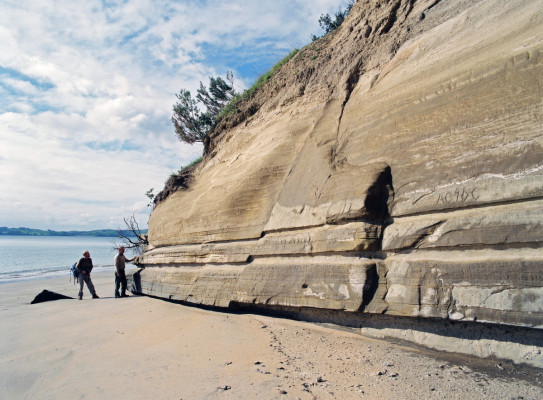
Evolution of the Zealandia megasequence

GNS Science has created a new series of paleogeographic maps covering the whole of Zealandia, going back to 98 Ma.
Overview
Understanding nearly 100 million years of tectonic activity across a whole continent is like playing with the ultimate geological jigsaw. The pieces change shape, size and position, the result of a complex mixture of subduction accretion, magmatism, rifting, and passive-margin sedimentation.
A GNS Science team, led by paleogeographer Dominic Strogen, has produced a suite of maps for the whole of Zealandia using a new geometrically rigorous tectonic reconstruction model. These maps show Zealandia’s geological evolution, from the mid-Cretaceous to present day, highlighting major tectonic phases, from initial Gondwana rifting through to the formation of the modern Neogene plate boundary.
The maps help resolve the distribution of elements such as land areas, sedimentary basins, volcanic arcs, and active fault systems. The project has synthesised large amounts of geological data producing maps on a retro-deformed basis, and placed accurately within an accurate latitude/longitude reference frame.
It has helped our scientific understanding by:
- summarising the long and complex geological history of Zealandia
- improving our understanding of our biological heritage through the location and size of landmasses and land bridges and by showing the extent of terrestrial and marine habitats through time
The project aimed to
- deliver a major advance in our understanding of Zealandia’s entire paleogeographic evolution by bringing together many years of research and compilation to produce these 15 maps
This project was funded by strategic science investment funding (SSIF) provided by the New Zealand Government to GNS Science as part of the Understanding Zealandia/Te Riu-a-Māui programme, and previously to the SSIF-funded Petroleum and Sedimentary Basins Research programmes. It incorporates many of the results of the Atlas of Petroleum Prospectivity (APP) programme, funded through the MBIE Energy and Minerals targeted research fund.
The project
Gaining new knowledge about Zealandia
The maps we’ve created help us to understand the whakapapa of Zealandia – how it came to be in its present form. We are learning more about its paleobiology; in simple terms, the rise, spread and fall of plant and animal species. Our participation in the International Ocean Discovery Program (IODP) has helped unveil Zealandia’s paleoclimate where we can use sediment cores to help see the future and provided crucial data for remote parts of Zealandia.
This project is the culmination of many years’ work for a large team of GNS scientists. As paleogeographer Dominic Strogen puts it, “Everything we know about geology of New Zealand and Zealandia went into the melting pot and we’re looking at what that mixture is showing us”.
“For example, Dr Rose Turnbull’s work on how Zealandia’s rocks fit the shape before it rifted from Gondwanaland. Our plate boundary team is looking at how and why certain faults rip. We’re working with our Antarctic team to find out how Zealandia ties to Australia and Antarctica.”
Understanding Zealandia underpins everything GNS Science does, because it’s literally the basis for all our geology and the development of the continent in its present form.
How we created the maps
We developed a tectonic framework to reconstruct Zealandia back to the mid-Cretaceous by:
- building on knowledge from previous tectonic reconstructions
- incorporating published seafloor magnetic interpretations, paleomagnetic observations and geological constraints
- dividing Zealandia into blocks to show how it moved
- overlaying these blocks with various geological data
- reviewing some 277 previous papers and studies from Adams and colleagues on the Coromandel Peninsula to Zink and colleagues on submarine fans with basins
These maps show the important phases of the Zealandia megasequence in c. 10 Myr blocks. While these maps cover broad time intervals, the team is looking at producing them for smaller time intervals covering the last few million years, to give insights into hazards, sea-level rise and climate change.
At the same time the maps are raising new questions with potential for further research.

Research project details
Duration
Funding platform
Strategic Science Investment Fund
Status
Leader
Dominic Strogen